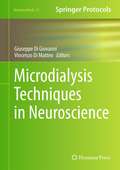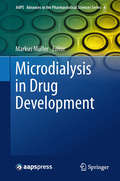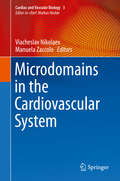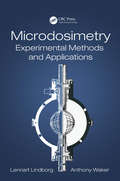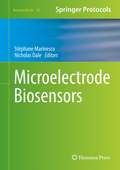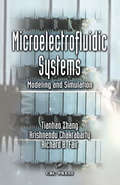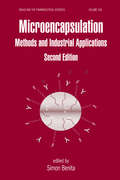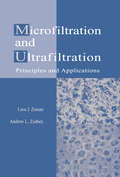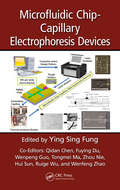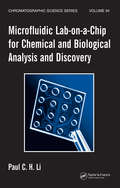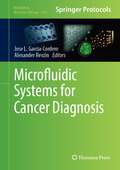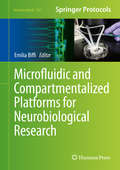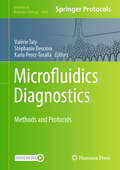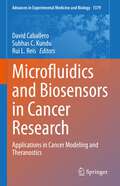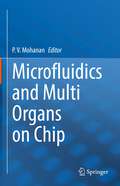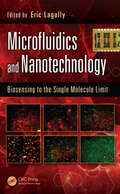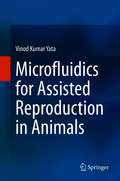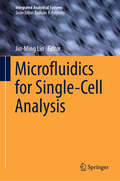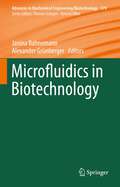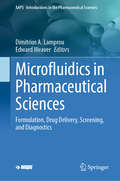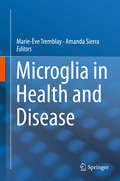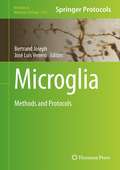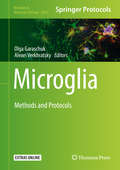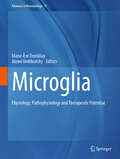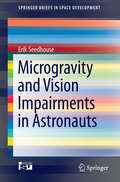- Table View
- List View
Microdialysis Techniques in Neuroscience
by Vincenzo Di Matteo Giuseppe Di GiovanniSince its first application, microdialysis has become incredibly popular to study brain function and has been applied with success in different fields from psychopharmacology, neurobiology, and physiology in animals and also humans. Microdialysis Techniques in Neuroscience focuses on the practical aspects of microdialysis in animal and human, highlighting current technical limitations and providing a vision of what is yet to come for the determination of the most disparate compounds in the brain. The book's contents range from new techniques for detection and quantifying the release of several different neurotransmitters in vitro and in vivo, even in freely moving animals, to sophisticated use of reverse dialysis and the application of microdialysis in pharmacokinetic studies. Each of the sixteen chapters, in fitting with the spirit of the Neuromethods series, contain an introduction that gives a broad overview of a focused topic, followed by an extensive protocol on how the experiments are performed along with invaluable practical advice. Detailed and authoritative, Microdialysis Techniques in Neuroscience will be a valuable reference for students, neuroscientists, and physicians for the use of microdialysis in the study of brain functions and its clinical applications.
Microdialysis in Drug Development
by Markus MüllerA vast number of diagnostic and therapeutic decisions are based on measuring blood concentrations of molecules, yet most biochemical and pharmacological events actually take place in the tissues. Microdialysis is a key semi-invasive sampling technique to measure in vivo drug penetration to the target site in humans, the method being feasible in virtually every organ. Authored by international experts in this cutting edge field, this book will provide a comprehensive overview of microdialysis and its application for measuring drug distribution in drug development.
Microdomains in the Cardiovascular System (Cardiac And Vascular Biology Ser. #4)
by Manuela Zaccolo Viacheslav NikolaevThe book comprehensively presents new findings in cardiovascular research related to signaling microdomains in health and disease. Important second messengers such as cAMP, cGMP, calcium and their role in microdomain signaling are discussed. The book offers and explains methodical approaches and technical ways how to successfully analyze microdomain signaling, also in the context of disease. It further provides scientific perspectives and strategies that are based on the concept of signaling within microdomains and that can revolutionize pharmacology and eventually lead to the effective treatment of cardiovascular diseases in future. This book is written for scientists in cardiovascular research, pharmacology, molecular and cellular biology as well as medical doctors in cardiology, angiology and nephrology.
Microdosimetry: Experimental Methods and Applications
by Anthony Waker Lennart LindborgExperimental microdosimetry deals with the measurement of charged particle energy deposition in tissue equivalent volumes, ranging in size from nanometres to micrometres. Microdosimetry is employed to improve our understanding of the relationship between radiation energy deposition, the resulting biological effects, and the appropriate quantities to be used in characterizing and quantifying radiation quality. Although many reviews and contributions to the field have been published over the past fifty years, this new book is the first to provide a single, up to date, and easily accessible account of experimental microdosimetry. This book is designed to be used in medical, radiation, and health physics courses and by Master’s and PhD students. In addition to serving as an introductory text to the field for graduate students, this book will also be of interest as a teaching and reference resource for graduate supervisors and established researchers. Drs. Lennart Lindborg and Anthony Waker have spent a life-time career in experimental microdosimetry research in academic, industrial and regulatory environments and have observed the development of the field from its early days as a recognized discipline; they bring to this book particular knowledge and experience in the design, construction, operation and use of tissue equivalent gas ionization counters and chambers.
Microelectrode Biosensors
by Stéphane Marinesco Nicholas DaleFor molecules that are not directly electroactive, it is necessary to modify a microelectrode by grafting polymeric or enzymatic membranes capable of translating a local concentration into an electrical current, which is a concept referred to as biosensing. In Microelectrode Biosensors, experts in the field cover the topic of electrochemical biosensor technology as applied to the neurosciences. The volume opens with a section addressing the specific issue of manufacturing biosensors that can be implanted in the central nervous system for neurotransmitter detection, and it then continues with sections on recent studies where biosensors have made a difference in bringing a new level of understanding of signaling mechanisms in neuroscience as well as recent developments in biosensor technology that have not yet been applied to implantable microelectrodes but may have great potential. Written for the Neuromethods series, this work contains the kind of detailed descriptions and implementation advice necessary to achieve successful results. Focused and cutting-edge, Microelectrode Biosensors serves to inspire the wider neuroscience and physiology community to adopt these powerful methods in their own applications in order to move the field forward with the widespread advances that will most likely flow from the adoption of biosensing as part of the standard laboratory toolkit.
Microelectrofluidic Systems: Modeling and Simulation (Nano- and Microscience, Engineering, Technology and Medicine)
by Tianhao Zhang Krishnendu Chakrabarty Richard B. FairComposite systems that integrate microelectromechanical and microelectrofluidic (MEF) components with electronics are emerging as the next generation of system-on-a-chip (SOC) designs. However, there remains a pressing need for a structured methodology for MEFS design automation, including modeling techniques and simulation and optimization tools. Integrating top-down and bottom-up design philosophies, Microelectrofluidic Systems presents the first comprehensive design strategy for MEFS. This strategy supports hierarchical modeling and simulation from the component level to the system level. It leads to multi-objective optimization tools valuable in all phases of the design process, from conceptualization to final manufacturing. The authors begin by defining the basic variables and elements needed to describe MEFS behavior, then model that behavior across three layers of abstraction: the low-level component, high-level reconfigurable architecture, and bio/chemical application layers. They have developed a hierarchical integrated design environment with SystemC and present its architecture and associated functional packages. Microelectrofluidic Systems is visionary in its leverage of electronic design principles for microsystem design and heralds a new era of automated SOC design. The strategy it presents holds the potential for significant reductions in design time and life-cycle maintenance costs, and its techniques and tools for robust design and application flexibility can lead to the high-volume production needed for the inevitably growing product market.
Microencapsulation: Methods and Industrial Applications, Second Edition (Drugs and the Pharmaceutical Sciences)
by Simon BenitaPresenting breakthrough research pertinent to scientists in a wide range of disciplines-from medicine and biotechnology to cosmetics and pharmacy-this Second Edition provides practical approaches to complex formulation problems encountered in the development of particulate delivery systems at the micro- and nano-size level. Completely revised and e
Microfiltration and Ultrafiltration: Principles and Applications
by ZemanIntegrates knowledge on microfiltration and ultrification, membrane chemistry, and characterization methods with the engineering and economic aspects of device performance, device and module design, processes, and applications. The text provides a discussion of membrane fundamentals and an analytical framework for designing and developing new filtrations systems for a broad range of technologically important functions. It offers information on membrane liquid precursors, fractal and stochastic pore space analysis, novel and advanced module designs, and original process design calculations.
Microfluidic Chip-Capillary Electrophoresis Devices
by Ying Sing FungCapillary electrophoresis (CE) and microfluidic chip (MC) devices are relatively mature technologies, but this book demonstrates how they can be integrated into a single, revolutionary device that can provide on-site analysis of samples when laboratory services are unavailable. By introducing the combination of CE and MC technology, Microfluidic Ch
Microfluidic Lab-on-a-Chip for Chemical and Biological Analysis and Discovery (Chromatographic Science Series)
by Paul C.H. LiThe microfluidic lab-on-a-chip allows scientists to conduct chemical and biochemical analysis in a miniaturized format so small that properties and effects are successfully enhanced, and processes seamlessly integrated. This microscale advantage translates into greater sensitivity, more accurate results, and better information. Microfluidic
Microfluidic Systems for Cancer Diagnosis (Methods in Molecular Biology #2679)
by Jose L. Garcia-Cordero Alexander RevzinThis detailed volume explores recent developments in microfluidics technologies for cancer diagnosis and monitoring. The book is divided into two sections that delve into techniques for liquid biopsy for cancer diagnosis and platforms for precision oncology or personalized medicine in order to create effective patient avatars for testing anti-cancer drugs. Written for the highly successful Methods in Molecular Biology series, chapters include introductions to their respective topics, lists of the necessary materials and reagents, step-by-step and readily reproducible laboratory protocols, and tips on troubleshooting and avoiding known pitfalls. Authoritative and practical, Microfluidic Systems for Cancer Diagnosis serves as an ideal guide that will be helpful to either replicate the construction of microfluidic devices specifically developed for cancer diagnosis or to catalyze development of new and better cancer diagnostic devices.
Microfluidic and Compartmentalized Platforms for Neurobiological Research
by Emilia BiffiThis volume presents cutting-edge techniques to design, fabricate and use compartmentalized microfluidic devices. Chapters encompass axon guidance and manipulation, compartmentalized devices for synapse manipulation, cell populations interaction either in physiological or pathological condition and compartmentalized devices for pharmacological research and drug discovery. Written in the popular Neuromethods series style, chapters include the kind of detail and key advice from the specialists needed to get successful results in your own laboratory. Authoritative and practical, Microfluidic and Compartmentalized Platforms for Neurobiological Research provides practical skills needed to fabricate, use microfluidics and compartmentalized platforms with neuronal cell cultures as well as the strengths of these exciting devices and their precious contribution in the field of Neuroscience.
Microfluidics Diagnostics: Methods and Protocols (Methods in Molecular Biology #2804)
by Valérie Taly Stéphanie Descroix Karla Perez-TorallaThis detailed volume explores a wide range of microfluidic-based approaches that exploit the unique features of microfluidic devices, which hold significant potential in the field of diagnosis. Beginning with a section on microchips for sample preparation, including cell-free DNA, exosomes, and cells, the book continues by covering protein marker analysis and detection, single-cell analysis, analysis of bacteria and viruses, as well as human cell-based culture and analysis. Written for the highly successful Methods in Molecular Biology series, chapters include introductions to their respective topics, lists of the necessary materials and reagents, step-by-step and readily reproducible laboratory protocols, and tips on troubleshooting and avoiding known pitfalls. Authoritative and practical, Microfluidics Diagnostics: Methods and Protocols serves as an ideal guide for researchers investigating how microfluidics can shape the future of diagnosis.
Microfluidics and Biosensors in Cancer Research: Applications in Cancer Modeling and Theranostics (Advances in Experimental Medicine and Biology #1379)
by Rui L. Reis David Caballero Subhas C. KunduThis book offers a comprehensive overview of the development and application of microfluidics and biosensors in cancer research, in particular, their applications in cancer modeling and theranostics.Over the last decades, considerable effort has been made to develop new technologies to improve the diagnosis and treatment of cancer. Microfluidics has proven to be a powerful tool for manipulating biological fluids with high precision and efficiency and has already been adopted by the pharmaceutical and biotechnology industries. With recent technological advances, particularly biosensors, microfluidic devices have increased their usefulness and importance in oncology and cancer research.The aim of this book is to bring together in a single volume all the knowledge and expertise required for the development and application of microfluidic systems and biosensors in cancer modeling and theranostics. It begins with a detailed introduction to the fundamental aspects of tumor biology, cancer biomarkers, biosensors and microfluidics. With this knowledge in mind, the following sections highlight important advances in developing and applying biosensors and microfluidic devices in cancer research at universities and in the industry. Strategies for identifying and evaluating potent disease biomarkers and developing biosensors and microfluidic devices for their detection are discussed in detail. Finally, the transfer of these technologies into the clinical environment for the diagnosis and treatment of cancer patients will be highlighted. By combining the recent advances made in the development and application of microfluidics and biosensors in cancer research in academia and clinics, this book will be useful literature for readers from a variety of backgrounds. It offers new visions of how this technology can influence daily life in hospitals and companies, improving research methodologies and the prognosis of cancer patients.
Microfluidics and Multi Organs on Chip
by P. V. MohananThis book highlights the application of microfluidics in cell biology research, chemical biology, and drug discovery. It covers the recent breakthroughs and prospects of organ-on-a-chip, human-on-a-chip, multi-organ-on-a-chip for personalized medicine. The book presents the preclinical studies of organs-on-a-chip, concepts of multiple vascularized organ-on-chips, application of organ-on-a-chip in blood-brain barrier model, culture and co-culture of cells on multi-organ-on-chip and parameter measurements in microfluidic devices. It underscores the advantage of microfluidic devices for developing efficient drug carrier particles, cell-free protein synthesis systems, and rapid techniques for direct drug screening. Further, it entails human-on-a-chip for measuring the systemic response as well as immediate effects of an organ reaction on other organs. In summary, this book reviews the development of a microfluidic-based organ-on-a-chip device for the preclinical evaluation, ADME studies of drugs, chemicals, and medical devices. This book is a valuable source for pharma companies, product developers, students, researchers, academicians, and practitioners.
Microfluidics and Nanotechnology: Biosensing to the Single Molecule Limit (Devices, Circuits, and Systems #27)
by Krzysztof Iniewski Eric LagallyAn increasing number of technologies are being used to detect minute quantities of biomolecules and cells. However, it can be difficult to determine which technologies show the most promise for high-sensitivity and low-limit detection in different applications. Microfluidics and Nanotechnology: Biosensing to the Single Molecule Limit details proven approaches for the detection of single cells and even single molecules—approaches employed by the world’s foremost microfluidics and nanotechnology laboratories. While similar books concentrate only on microfluidics or nanotechnology, this book focuses on the combination of soft materials (elastomers and other polymers) with hard materials (semiconductors, metals, and glass) to form integrated detection systems for biological and chemical targets. It explores physical and chemical—as well as contact and noncontact—detection methods, using case studies to demonstrate system capabilities. Presenting a snapshot of the current state of the art, the text: Explains the theory behind different detection techniques, from mechanical resonators for detecting cell density to fiber-optic methods for detecting DNA hybridization, and beyond Examines microfluidic advances, including droplet microfluidics, digital microfluidics for manipulating droplets on the microscale, and more Highlights an array of technologies to allow for a comparison of the fundamental advantages and challenges of each, as well as an appreciation of the power of leveraging scalability and integration to achieve sensitivity at low cost Microfluidics and Nanotechnology: Biosensing to the Single Molecule Limit not only serves as a quick reference for the latest achievements in biochemical detection at the single-cell and single-molecule levels, but also provides researchers with inspiration for further innovation and expansion of the field.
Microfluidics for Assisted Reproduction in Animals
by Vinod Kumar YataThis book describes the fundamentals of microfluidics and fabrication methods of microfluidic devices that can be adopted for animal-assisted reproduction. It presents microfluidic methods for sorting highly fertile spermatozoa. This book also describes the application of microfluidics in vitro fertilization and embryo culture. It discusses the use of microfluidics in sperm sexing and the cryopreservation of animal gametes and embryos. Lastly, the book examines the potential opportunities of microfluidics in infertility diagnosis, sperm selection and guidance, oocyte selection, insemination, and embryo monitoring.
Microfluidics for Single-Cell Analysis (Integrated Analytical Systems)
by Jin-Ming LinThis book summarizes the various microfluidic-based approaches for single-cell capture, isolation, manipulation, culture and observation, lysis, and analysis. Single-cell analysis reveals the heterogeneities in morphology, functions, composition, and genetic performance of seemingly identical cells, and advances in single-cell analysis can overcome the difficulties arising due to cell heterogeneity in the diagnostics for a targeted model of disease. This book provides a detailed review of the state-of-the-art techniques presenting the pros and cons of each of these methods. It also offers lessons learned and tips from front-line investigators to help researchers overcome bottlenecks in their own studies. Highlighting a number of techniques, such as microfluidic droplet techniques, combined microfluidics-mass-spectrometry systems, and nanochannel sampling, it describes in detail a new microfluidic chip-based live single-cell extractor (LSCE) developed in the editor’s laboratory, which opens up new avenues to use open microfluidics in single-cell extraction, single-cell mass spectrometric analysis, single-cell adhesion analysis and subcellular operations. Serving as both an elementary introduction and advanced guidebook, this book interests and inspires scholars and students who are currently studying or wish to study microfluidics-based cell analysis methods.
Microfluidics in Biotechnology (Advances in Biochemical Engineering/Biotechnology #179)
by Janina Bahnemann Alexander GrünbergerThis new volume introduces the applications of microfluidic systems to facilitate biotechnological and biomedical processes. It provides an overview on cutting-edge technologies, summarizes traditional and modern fabrication methods and highlights recent advances regarding the application of lab-on-a-chip (LoC) systems for bioanalytical purposes. This book is ideal for research scientists and students interested at the cross-section between biotechnology, chemistry and chemical engineering.
Microfluidics in Pharmaceutical Sciences: Formulation, Drug Delivery, Screening, and Diagnostics (AAPS Introductions in the Pharmaceutical Sciences #14)
by Dimitrios A. Lamprou Edward WeaverThe book covers the basics of microfluidics, current applications in areas such as formulation, drug delivery, drug screening and development, monitoring and diagnostics, and case studies from a teaching perspective to undergraduate and postgraduate students, allowing application of the content in a flipped classroom. Multiple choice questions are included at the end of each chapter. All chapter authors are pioneers and world leaders. This is an ideal book for students, researchers, and industry professionals working on microfluidics in the pharmaceutical sciences.
Microglia in Health and Disease
by Marie-Ève Tremblay Amanda SierraThese past few years have witnessed a revolution in our understanding of microglia, especially since their roles in the healthy central nervous system (CNS) have started to unravel. These cells were shown to actively maintain health, in concert with neurons and other types of CNS cells, providing further insight into their involvement with diseases. Edited by two pioneers in the field, Marie-Ève Tremblay and Amanda Sierra, Microglia in health and disease aims to share with the broader scientific community some of the recent discoveries in microglia research, from a broad perspective, with a collection of 19 chapters from 52 specialists working in 11 countries across 5 continents. To set microglia on the stage, the book begins by explaining briefly who they are, what they do in the healthy and diseased CNS, and how they can be studied. The first section describes in more details their physiological roles in the maturation, function, and plasticity of the CNS, across development, adolescence, adulthood, neuropathic pain, addiction, and aging. The second section focuses on their implication in pathological conditions impairing the quality of life: neurodevelopmental and neuropsychiatric disorders, AIDS, and multiple sclerosis; and in leading causes of death: ischemia and stroke, neurodegenerative diseases, as well as trauma and injury.
Microglia: Methods and Protocols
by José Luis Venero Bertrand JosephKey discoveries concerning the different biological functions of microglia in health and disease have attracted scientists from various fields. In Microglia: Methods and Protocols, expert researchers in the field detail methods for selection of the key cellular, molecular and biochemical techniques that are used in studying the many and varied functions of this fascinating cell. These methods and techniques include microglia cell culture for studying microglia activation and functions, as well as their interaction with other cell types both in vitro and in vivo. Written in the highly successful Methods in Molecular Biology series format, chapters include introductions to their respective topics, lists of the necessary materials and reagents, step-by-step, readily reproducible laboratory protocols, and key tips on troubleshooting and avoiding known pitfalls. Authoritative and practical, Microglia: Methods and Protocols is a useful resource for cell biologists, molecular biologists, immunologists, oncologist and neuroscientists.
Microglia: Methods and Protocols (Methods in Molecular Biology #2034)
by Alexei Verkhratsky Olga GaraschukThis book presents a comprehensive toolkit of versatile techniques for studying microglia under different experimental settings along with a brief summary of knowledge, accumulated in microglial research over the last decades. Beginning with recently discovered roles of microglia in health and disease, the volume continues by covering in vitro analyses of microglia, in vivo studies, and “omics” analyses. Written for the highly successful Methods in Molecular Biology series, chapters include introductions to their respective topics, lists of the necessary materials and reagents, step-by-step, readily reproducible laboratory protocols, and tips on troubleshooting and avoiding known pitfalls. Authoritative and cutting-edge, Microglia: Methods and Protocols serves as a vital guide to these important cells and an inspiration for scientists interested in expanding our knowledge of their role in the nervous system.
Microglia: Physiology, Pathophysiology and Therapeutic Potential (Advances in Neurobiology #37)
by Alexei Verkhratsky Marie-Ève TremblayThe past decade has witnessed a revolution in our understanding of microglia, especially since their roles in the healthy CNS have started to unravel. These cells were shown to actively maintain health, in concert with neurons and other types of CNS cells, providing further insight into their crucial involvement with diseases. Edited by Drs. Marie-Ève Tremblay and Alexei Verkhratsky, Microglia: Physiology, Pathophysiology and Therapeutic Potential shares with the scientific and medical community the latest discoveries in the microglial research field, with a truly comprehensive collection of chapters written by the top specialists across five continents. The book begins by explaining briefly what they are, from both historical and evolutionary points of view, and how they can be studied. The first section explains their physiological roles in the maturation, function, and plasticity of the CNS. The second section focuses on their general involvement in neuropathophysiology, and the third section on their critical implication in specific CNS diseases, including neurotrauma, neuropathic pain, ischemia and stroke, infectious diseases, autoimmune diseases, neurodevelopmental and neuropsychiatric disorders, substance use and addiction, sleep disorders, ageing, and neurodegenerative diseases. The fourth section presents their clinical potential as a targeted therapeutic tool for these CNS diseases.
Microgravity and Vision Impairments in Astronauts
by Erik SeedhouseRecent missions on board the International Space Station have revealed previously unreported physiological consequences of long duration space flight, particularly in eyesight, and in this Brief Dr. Seedhouse reviews the existing theories on what causes this degeneration and how long it will last. Notably, 60% of long-duration crews have reported subjective degradation in vision, a clear indication that further study is necessary before astronauts embark on even longer-term space missions. Decreased near-visual acuity was reported in 46% of ISS/Mir crewmembers, resulting in a change of up to 2 dioptres in their refractive correction. It is possible that ophthalmic changes have been present since the first days of spaceflight, but had been attributed to other causes; this approach to the issue as well as other hypotheses are all presented in full to give a broad foundation of the existing knowledge on the topic. The changes have occurred at various times during a mission with varying degrees of visual degradation. Some cases resolved on return to Earth, but several crewmembers have not regained pre-flight visual acuity, indicating the damage may be permanent. One explanation of the syndrome has been attributed to hyperopic shift due to aging, but onboard analysis techniques, including visual acuity assessments, retinal imagery, and ultrasound examination of the eye, has led to the acceptance of a wider syndrome. In addition to vision changes, studies have reported flattening of the globe, swelling of the optic disc (papilledema), choroidal folds in the retina, swelling of the optic nerve sheath, and visual field defects. It is widely hypothesized that this spectrum of symptoms may be explained by an elevation of intracranial pressure (ICP). Establishing the provenance of this medical problem, monitoring its occurrence and resolving the symptoms for future long term space missions is a key challenge for space medicine. With this book, readers have an entry point for understanding the full scope of the problem and its possible origins.
